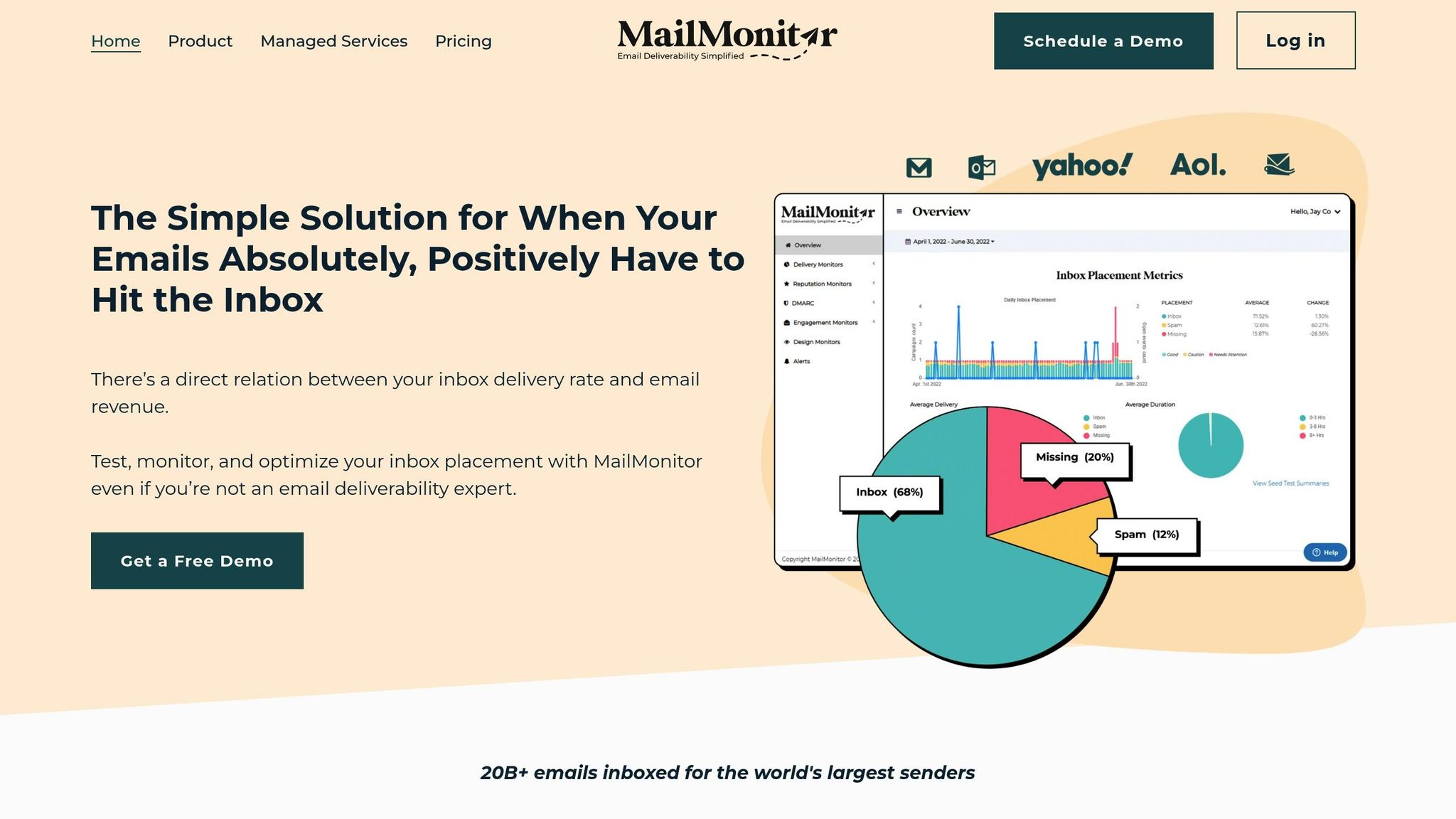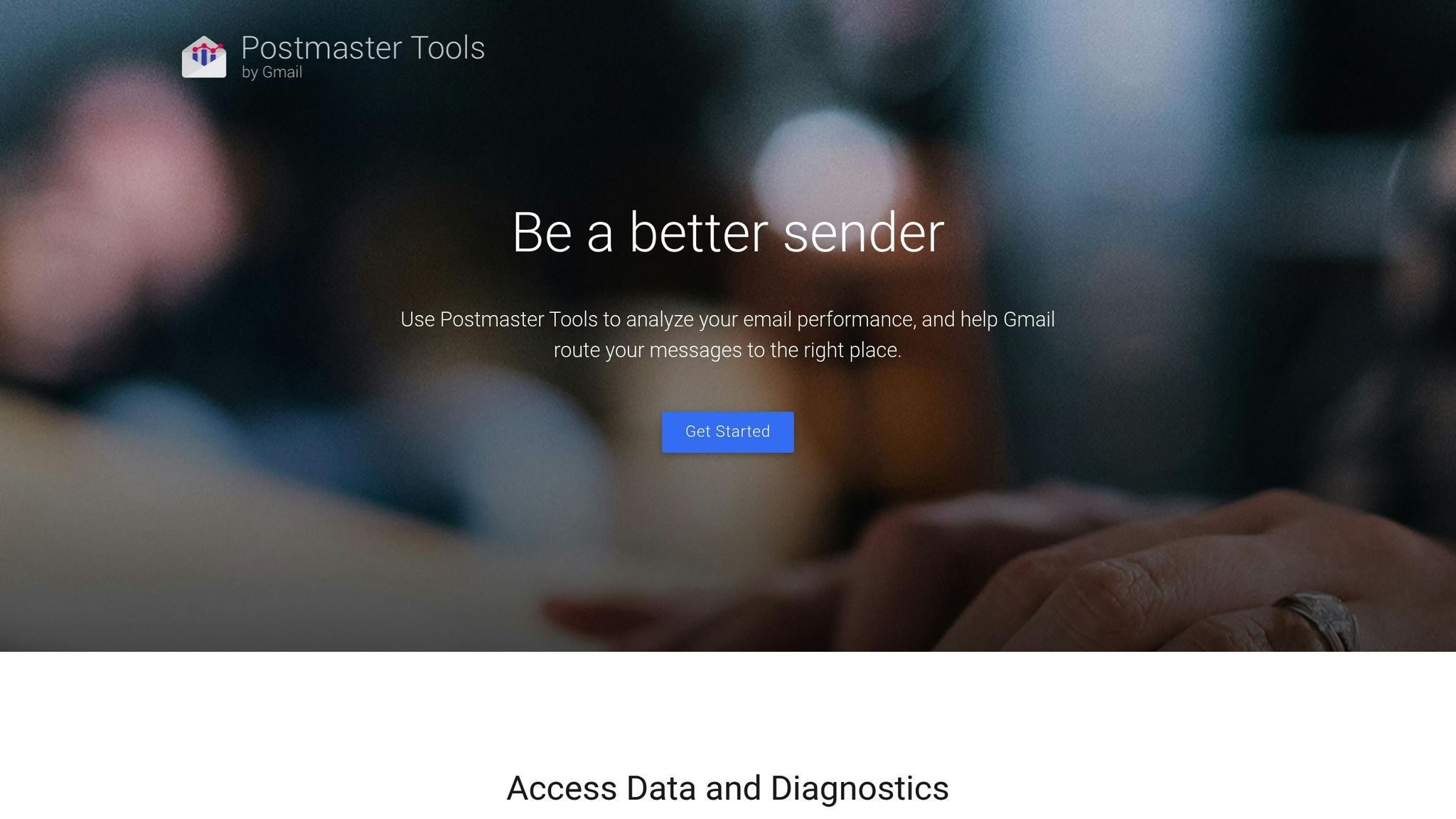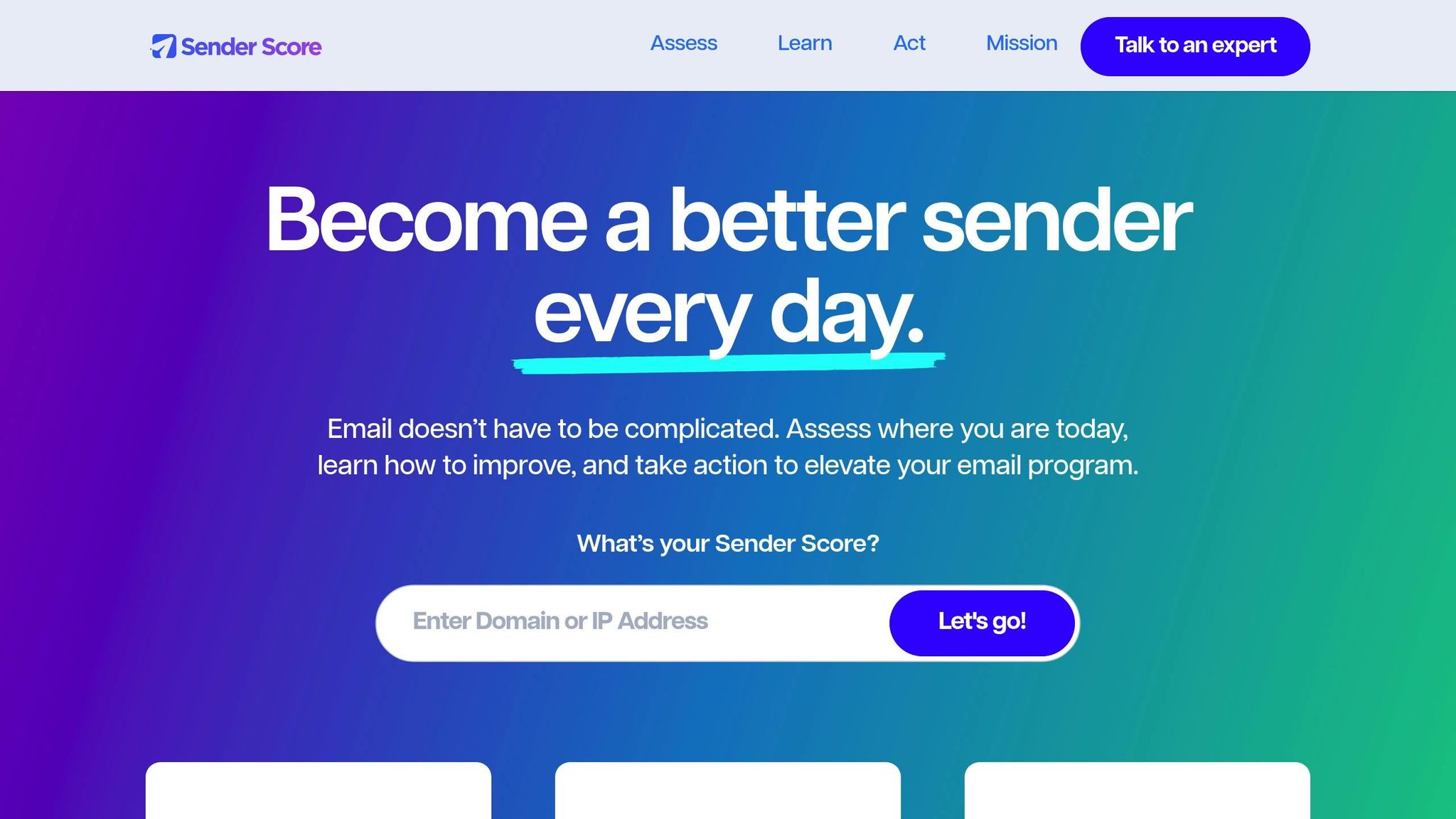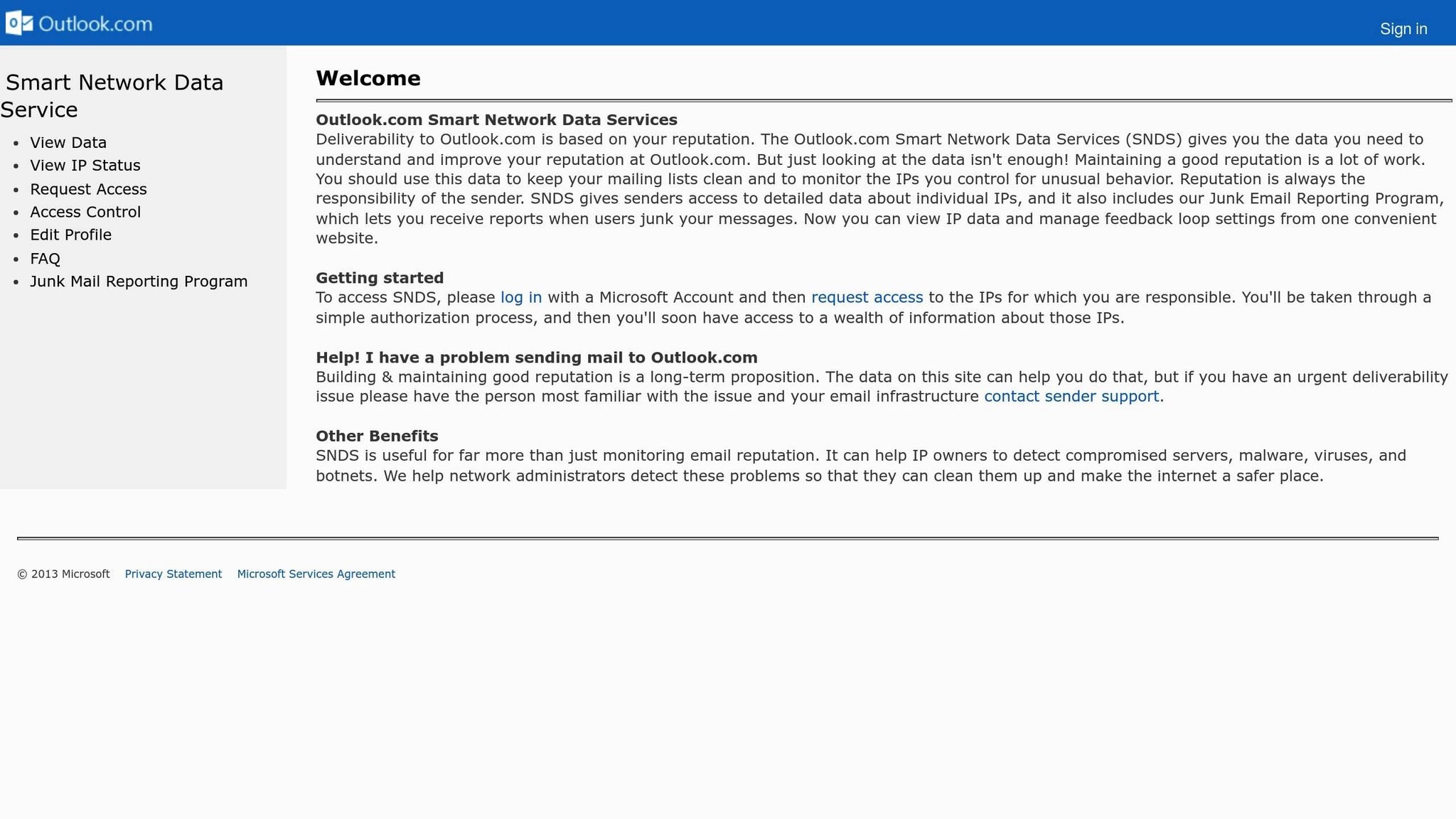Did you know? Around 25% of emails never reach inboxes due to poor sender reputation. Monitoring your email reputation is key to ensuring your messages land where they should – your subscribers’ inboxes.
Why Email Reputation Matters:
- What It Is: Your email reputation acts like a “credit score” for your email-sending practices. Internet Service Providers (ISPs) use it to decide whether your emails go to inboxes or spam.
- Why Monitor It: A low reputation can cause bounces, spam folder placement, or blocks, hurting your campaigns and brand trust.
- How to Improve: Tools like MailMonitor and proper email practices (e.g., list hygiene, authentication) can help you maintain a strong reputation.
Key Metrics to Watch:
- Sender Score: A score from 0-100 that reflects your email-sending quality. Aim for 90+ for high deliverability.
- Inbox Placement Rates: Tracks how many emails reach inboxes vs. spam. High Sender Scores often lead to 95% inbox placement.
- Bounce Rates: Keep this below 5% (ideally under 2%) to avoid harming your reputation.
- Engagement Metrics: Low spam complaints (<0.1%) and strong open/click rates signal healthy email performance.
Tools to Help:
- MailMonitor: Tracks inbox placement, spam issues, and blocklists.
- Google Postmaster Tools: Offers insights into Gmail-specific performance.
- Sender Score by Validity: Evaluates your IP reputation across ISPs.
- Microsoft SNDS: Monitors your reputation within Microsoft’s ecosystem.
Quick Comparison of Tools:
| Tool | Key Features | Best For | Cost |
|---|---|---|---|
| MailMonitor | Inbox placement, blocklist tracking | Comprehensive reputation monitoring | Starts at $49/month |
| Google Postmaster Tools | Gmail-specific insights | Gmail senders | Free |
| Sender Score by Validity | IP reputation scoring | Broad reputation overview | Free |
| Microsoft SNDS | Microsoft-specific reputation tracking | Outlook/Hotmail senders | Free |
Start Now: Regularly monitor your email reputation, clean your lists, and set up proper authentication to keep your emails out of spam folders. Tools like MailMonitor make it easier to stay ahead of issues and protect your sender reputation.
How To Check Your Sender Reputation: The Methods That Actually Work
Key Email Reputation Metrics
Understanding key metrics is essential for evaluating your email reputation and ensuring strong deliverability. These metrics not only highlight your current performance but also reveal areas where improvements can make a big difference. Together, they create a clear picture of your email reputation, helping you fine-tune your campaigns.
Sender Score
The Sender Score, a value ranging from 0 to 100, reflects the quality of your email-sending practices.
Mailbox providers use these scores to gauge your reputation. For example, Gmail typically requires a Sender Score above 90 for an average inbox placement rate of over 80%. Similarly, Microsoft expects a score above 90 to achieve a maximum inbox placement rate of 72%.
| Score Range | Reputation Status | Deliverability Impact | Action Required |
|---|---|---|---|
| 90-100 | Excellent | High inbox placement (about 95%) | Continue following best practices and monitor performance |
| 70-89 | Good | Decent deliverability, but room for improvement | Check for issues like bounce rates or spam complaints |
| 50-69 | Fair | Delivery to inboxes may be affected | Focus on improving list hygiene, authentication, and content |
| Below 50 | Poor | Major deliverability problems; emails likely blocked or marked as spam | Review and overhaul your email practices, including list management |
Sender Scores are a critical starting point, but inbox placement rates provide a deeper look at your deliverability.
Inbox Placement Rates
Inbox placement rates track how many of your emails make it to recipients’ primary inboxes instead of spam folders, promotions tabs, or being blocked altogether. Providers combine sender scores with other factors – like engagement and content quality – to determine where your emails land.
A high Sender Score (90-100) often results in about 95% inbox placement, while a score below 70 might lead to only 50% deliverability. Clearly, maintaining a strong sender reputation is key to keeping your emails where they belong: in the inbox.
Bounce Rates and List Quality
Your bounce rate is a direct reflection of your list quality and has a significant impact on your sender reputation. High bounce rates signal poor list hygiene and can hurt your chances of getting replies. Aim to keep bounce rates below 5%, with 2% or less being the ideal target.
Bounces can be divided into two types:
- Hard bounces: Permanent issues, like invalid email addresses, that severely harm your reputation.
- Soft bounces: Temporary issues, such as full inboxes, which still indicate potential list problems.
To maintain a low bounce rate, regularly clean your email lists. Removing invalid or inactive addresses not only protects your reputation but also ensures you’re targeting engaged recipients.
Engagement Metrics
Metrics like opens, clicks, complaints, and unsubscribes measure how well your emails are performing. These signals also inform Internet Service Providers (ISPs) about your sender reputation.
Spam complaints are especially critical. According to Google’s guidelines, your spam complaint rate should stay below 0.1%, with a target of under 0.03%. The average spam complaint rate is usually less than 0.08%.
Unsubscribe rates are another useful indicator. If your unsubscribe rate exceeds 0.5%, it might mean your emails are either irrelevant or sent too often. On the other hand, strong open and click-through rates suggest healthy engagement. For example:
- Subject lines with 6 to 10 words often achieve a 21% open rate.
- Using personalized sender names can boost open rates by 30%.
Email Reputation Monitoring Tools
Using the right tools to track your email reputation can make a world of difference. These platforms provide unique insights into how mailbox providers perceive your sending practices, helping you maintain and improve your sender reputation.
MailMonitor

MailMonitor offers a detailed look at email deliverability through a global network of seed accounts. It helps identify spam folder placement issues and suggests improvements like blocklist removal and DNS authentication fixes. The tool also tracks hundreds of blocklists and monitors DNS/DMARC settings, sending custom alerts when problems arise.
“It was impressive to see how quickly email clients and platforms in the marketplace were reacting to my emails to my contacts nationally. I could easily tell which of my emails were getting through and which ones weren’t. And when they weren’t, MailMonitor helped remedy that.” – Todd B.
With plans starting at $49.00 per month, MailMonitor provides robust monitoring capabilities without breaking the bank. It’s a valuable addition to any deliverability strategy.
Google Postmaster Tools

Google Postmaster Tools is a must-have for anyone sending large volumes of email to Gmail users. It provides direct insights into how Google views your domain and IP reputation. The platform tracks key metrics like spam rates and authentication status, offering a clear picture of your email performance.
This tool separates domain and IP reputation data and highlights spam complaint rates, helping you pinpoint whether issues stem from your sending practices or technical setup. It also monitors the status of SPF, DKIM, and DMARC records as seen by Google. While it requires a minimum volume of Gmail traffic to activate, the insights it provides are invaluable once operational.
Sender Score by Validity

Sender Score evaluates your IP reputation across multiple ISPs, assigning a score between 0 and 100 based on factors like spam complaints, sending volume, and spam trap hits. Scores above 90 indicate strong reputation, while scores below 70 suggest major issues.
While Sender Score offers a broad view of your reputation, it’s best used alongside provider-specific tools for a more complete understanding of your deliverability performance.
Microsoft SNDS

Microsoft Smart Network Data Services (SNDS) focuses on your reputation within Microsoft’s email ecosystem, covering services like Outlook.com and Hotmail. It provides IP-specific data, including spam trap hits and complaint rates, to show how Microsoft views your sending IP.
With new Microsoft authentication standards set to take effect on May 5, 2025, monitoring SNDS has become even more critical. Though it requires registering your sending IPs, the detailed insights it offers are essential for understanding and improving your reputation within Microsoft’s ecosystem.
sbb-itb-eece389
How to Maintain and Improve Email Reputation
Maintaining a solid email reputation takes effort, but it’s worth it. By following proven strategies, you can show mailbox providers that you’re a reliable sender who respects subscribers and adheres to best practices.
List Hygiene and Segmentation
Your email reputation starts with your list. A clean, well-maintained list helps ensure your emails reach the inbox. Regular list hygiene means sending emails only to valid and engaged addresses, which is crucial since the average email list shrinks by about 22% annually.
“Email list hygiene is like normal hygiene – it should be a regular part of your routine.” – Jesse Sumrak, Twilio
To keep your list healthy, use a double opt-in process to prevent spam traps, bots, and typos from sneaking in. Make it easy for subscribers to opt out by including a clear unsubscribe link in every email. Instead of clinging to inactive users, embrace natural list churn. Removing unengaged subscribers reduces the risk of spam complaints.
Consider implementing a sunset policy to remove subscribers who haven’t interacted with your emails in 3–6 months. Before cutting them off, try a re-engagement campaign to win them back. Segmentation also plays a big role – grouping subscribers by behavior, demographics, or purchase history allows you to send more targeted and relevant emails. Segmented campaigns see 46% higher open rates, and personalized emails drive 58% of all revenue.
Automating email validation during sign-ups and promptly suppressing invalid addresses can further protect your reputation. Surprisingly, 38.7% of senders rarely or never practice proper list hygiene, making this an area where you can stand out.
Email Authentication Setup
Once your list is in good shape, turn your attention to securing your sending domain. Email authentication protocols – SPF, DKIM, and DMARC – are essential for building trust with mailbox providers. These protocols help prevent spammers from impersonating your domain. Without them, your emails could end up flagged as spam or blocked entirely.
- SPF specifies which IP addresses are allowed to send emails on your behalf.
- DKIM adds a digital signature to verify that your emails haven’t been tampered with during transit.
- DMARC builds on SPF and DKIM, telling mailbox providers how to handle emails that fail authentication checks.
“All of these requirements have been well-documented best practices for years. A lot of senders have already implemented them. Authenticating your email traffic should be something that you’re already doing if you care about the health of your email traffic as well as your infrastructure.” – Marcel Becker, Yahoo
Proper authentication improves deliverability. For instance, companies adopting a DMARC enforcement policy have seen delivery rates rise by 5–10% for marketing emails. However, research from Valimail shows that 75–80% of domains with DMARC records struggle to achieve full enforcement. Start by configuring SPF, DKIM, and DMARC in your domain’s DNS settings. Begin with a DMARC policy of p=none to monitor email traffic, and gradually move to stricter policies like p=quarantine or p=reject once you’re confident in your setup.
“The end goal is ideally a policy of p=reject. That’s what DMARC is for. Ensuring that your domain cannot be spoofed and protecting our mutual customers from abuse.” – Marcel Becker, Yahoo
Regularly monitor your email traffic to catch any authentication issues early. With Business Email Compromise scams estimated to cost $50 billion globally, robust email authentication is more important than ever.
IP Warming and Blocklist Removal
If you’re using a new IP address or recovering from a damaged reputation, IP warming is a must. This process involves gradually increasing your email volume to build trust with ISPs. Start small by sending to your most engaged subscribers, and slowly scale up over days or weeks. Keep an eye on engagement metrics like open rates, click-through rates, and spam complaints. Consistency in sending frequency is also key. Don’t forget to authenticate all emails with SPF, DKIM, and DMARC during this process.
If your IP gets blocklisted due to complaints or invalid addresses, identify the cause, contact the blocklist provider for removal, and rebuild your reputation using IP warming techniques. Tools like MailMonitor can simplify this process by tracking blocklists and providing step-by-step guidance for resolution.
Setting Up Custom Alerts
To stay ahead of potential issues, monitor your email reputation in real time. Tools like MailMonitor allow you to set up custom alerts for problems such as a sudden drop in inbox placement, increased spam folder delivery, or a new blocklist appearance. These alerts can also flag authentication failures, which might indicate DNS misconfigurations or spoofing attempts.
Track changes in engagement rates across different ISPs. For example, a decline in Gmail engagement could point to a domain reputation issue, while widespread problems might signal broader sending practice concerns. MailMonitor’s global network of seed accounts provides insights into these trends, giving you early warnings of potential problems. Alerts for bounce rate spikes can help you quickly address list quality or delivery issues. The key is finding a balance – start with alerts for major issues and fine-tune them as you get more comfortable with your metrics.
How to Fix Reputation Problems
If your emails are suddenly landing in spam folders or you’re seeing a spike in bounce rates, it’s time to act quickly. Ignoring these issues can lead to long-term damage to your email deliverability. The solution lies in diagnosing the problem and taking specific steps to recover.
Finding the Root Cause
Email reputation issues often build up over time but become glaringly obvious when your metrics take a hit. For example, Gmail and Yahoo expect a spam complaint rate of 0.3% or less. Even a slight increase can set off alarms and hurt your deliverability.
Start by analyzing your email performance metrics. Look for patterns like declining open rates, higher bounce rates, or increased spam complaints. If engagement drops across all email providers, it’s likely a widespread issue. On the other hand, if the problem is isolated to Gmail or Outlook, it could be specific to those domains.
Next, check your email authentication settings. Misconfigured or failing SPF, DKIM, and DMARC records can harm your reputation. Tools like Google Postmaster Tools can help you verify if your authentication setup is working correctly and spot any errors.
Don’t overlook your email list quality. High bounce rates could mean your list contains invalid addresses, while low engagement might indicate you’re emailing people who aren’t interested. Spam complaints are another red flag – if too many recipients mark your emails as spam, most of your audience may never even see them.
Finally, check if your sending IP or domain is listed on major blocklists. Being flagged on these lists can significantly hurt your deliverability, as many email providers automatically filter messages from problematic senders.
| Root Cause | Warning Signs | Immediate Actions |
|---|---|---|
| Poor List Quality | High bounce rates, low engagement | Remove invalid addresses, focus on active users |
| Authentication Issues | DMARC failures, spoofing reports | Correct SPF/DKIM/DMARC records |
| Blocklist Inclusion | Sudden delivery drops | Check blocklists, request removal |
| High Spam Complaints | Complaint rates above 0.3% | Revise content, improve audience targeting |
Once you’ve identified the root cause, you can move on to targeted recovery efforts.
Using MailMonitor for Recovery
After pinpointing the problem, tools like MailMonitor can help you recover quickly and effectively. MailMonitor’s real-time audits and alerts allow you to identify and address issues with precision. Its global network of seed accounts gives you insights into how your emails are being treated across various ISPs and regions.
MailMonitor’s deliverability audit is particularly useful for diagnosing trouble spots. It evaluates your sending practices, authentication setup, and list quality to highlight areas that need improvement. This approach saves you from trial-and-error fixes that could make things worse.
The platform also offers custom alerts for key metrics like inbox placement rates, spam folder delivery, and blocklist appearances. These alerts keep you informed about your recovery progress and help you catch new issues early.
MailMonitor’s DMARC monitoring feature ensures that your authentication remains properly configured throughout the recovery process. This continuous oversight helps prevent recurring problems that could stall your progress.
For more severe reputation issues, MailMonitor’s managed services team can step in with tailored recovery strategies. Whether it’s IP warming, segmenting your list, or tweaking your content, their expertise can speed up the recovery process.
Additionally, MailMonitor simplifies blocklist removal by guiding you through the process of contacting blocklist operators and documenting the steps you’ve taken to fix the problem. The platform also tracks your removal requests and monitors for re-listings, ensuring you stay off those lists.
Ongoing Monitoring and Prevention
Once you’ve resolved the issue, the work doesn’t stop. To prevent future problems, you need to keep a close eye on your email metrics and maintain good practices. Reputation monitoring should be an ongoing effort, not a one-time fix.
Regular audits are essential. Depending on your email volume and program complexity, schedule these checks monthly or quarterly to catch potential problems early.
“You’re a guest in your subscriber’s inboxes, so respect what they have told you.” – Carin Slater, Manager of Lifecycle Email Marketing at Litmus
Pay attention to engagement trends. If open or click-through rates start to decline, it’s a sign that your reputation might be slipping. Review your content strategy, frequency of sends, and segmentation practices to address these early warning signs.
Set up feedback loops with major ISPs to receive real-time alerts when recipients mark your emails as spam. This allows you to act quickly and adjust campaigns before the damage spreads.
Maintain strict list hygiene by removing inactive subscribers. Consider implementing a sunset policy to remove users who haven’t engaged in 90-120 days. While it may seem counterproductive, a smaller, more engaged list often leads to better deliverability.
“It’s much better to have a smaller, highly engaged email list than a larger one full of random email addresses for deliverability.” – Carin Slater, Manager of Lifecycle Email Marketing at Litmus
Keep in mind that 70% of subscribers have unsubscribed from at least three brands in the last three months due to email overload. This highlights the importance of sending relevant and timely content.
Finally, use pre-send testing tools to catch potential issues before your campaigns go live. These tools can flag problems like blocklist status or authentication failures, helping you avoid reputation damage.
With spam accounting for 45% of global emails and 15.8% of emails getting caught by spam filters, maintaining a clean email reputation requires constant vigilance and adherence to best practices.
Conclusion
Monitoring your email reputation isn’t just a technical task – it’s the backbone of effective email marketing. With sender reputation metrics accounting for 80% of email deliverability and 25% of emails failing to land in inboxes due to reputation issues, this is something businesses simply can’t overlook. The stakes are high, but the rewards are undeniable. Email marketing boasts an impressive ROI, potentially delivering $42 for every $1 spent. Of course, this only holds true if your emails actually make it to your audience’s inbox.
Several factors shape your sender reputation, including bounce rates, spam complaints, recipient engagement, authentication protocols, and the quality of your content. These elements require constant vigilance. Considering that nearly 45% of all emails sent are classified as spam and 70% of emails encounter at least one spam-related issue, maintaining a strong reputation involves quick action when challenges arise.
Advanced tools can make this process far more manageable. As discussed earlier, MailMonitor offers a comprehensive solution, providing real-time insights into email performance across major ISPs. With its suite of tools, you gain the visibility needed to optimize delivery rates. Features like custom alerts help you address problems before they escalate, while their managed services team provides expert support for more complex reputation issues.
In short, email reputation monitoring is not a one-and-done task – it’s an ongoing responsibility. Regular audits, maintaining clean email lists, using proper authentication methods, and continuously tracking engagement are all vital for safeguarding your sender reputation and maximizing your email marketing ROI.
With a solid strategy and the capabilities of MailMonitor, you can ensure your emails consistently reach inboxes, resonate with your audience, and deliver the results that make email marketing such a powerful channel for your business.
FAQs
How does having a poor email reputation affect my email marketing efforts?
A weak email reputation can seriously disrupt your email marketing efforts. When your reputation takes a hit, fewer of your emails make it to your customers’ inboxes. Instead, they often land in spam folders, which means fewer people open them, engagement drops, and you miss chances to boost sales.
In extreme cases, Internet Service Providers (ISPs) might block or reject your emails altogether. This not only makes it tougher to reach your audience but can also erode customer trust and hurt your relationship with subscribers. To keep your campaigns running smoothly and effectively, it’s crucial to build and protect a strong email reputation.
How can I improve and maintain a high Sender Score to boost email deliverability?
To keep your Sender Score in good shape, start by cleaning up your email list regularly. Remove inactive or invalid addresses to lower bounce rates and make sure your emails are landing in the inboxes of people who actually want them. It’s also important to focus on crafting content that’s relevant and engaging – this encourages recipients to open and interact with your emails, which boosts your reputation.
Make sure your domain is authenticated using SPF, DKIM, and DMARC protocols. These not only help email providers trust that your messages are legitimate but also protect your domain from being used for spam. Additionally, maintain a steady email-sending pattern. Sudden spikes in volume can raise red flags and hurt your reputation.
Don’t forget to keep an eye on your email reputation metrics. Use tools to track important data like inbox placement rates and sender reputation. This allows you to quickly spot and fix any issues before they start affecting your email deliverability.
How can MailMonitor help keep my emails out of spam folders?
MailMonitor helps you ensure your emails land where they’re supposed to – your recipients’ inboxes. It does this by keeping an eye on crucial factors like sender reputation, IP health, and inbox placement rates. These elements heavily influence how spam filters judge your emails. If issues like a low sender score or flagged content arise, MailMonitor doesn’t just alert you – it offers clear, actionable steps to fix them.
Beyond monitoring, MailMonitor equips you with tools to safeguard your domain and IP reputation. It assists in maintaining a clean email list, authenticating your emails, and steering clear of practices that might trigger spam filters. By taking these steps, you can drastically cut down the chances of your emails being flagged, helping them land safely in your audience’s inbox.



